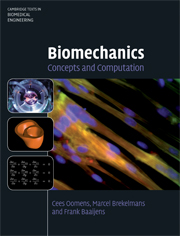Book contents
- Frontmatter
- Contents
- About the cover
- Preface
- 1 Vector calculus
- 2 The concepts of force and moment
- 3 Static equilibrium
- 4 The mechanical behaviour of fibres
- 5 Fibres: time-dependent behaviour
- 6 Analysis of a one-dimensional continuous elastic medium
- 7 Biological materials and continuum mechanics
- 8 Stress in three-dimensional continuous media
- 9 Motion: the time as an extra dimension
- 10 Deformation and rotation, deformation rate and spin
- 11 Local balance of mass, momentum and energy
- 12 Constitutive modelling of solids and fluids
- 13 Solution strategies for solid and fluid mechanics problems
- 14 Solution of the one-dimensional diffusion equation by means of the Finite Element Method
- 15 Solution of the one-dimensional convection-diffusion equation by means of the Finite Element Method
- 16 Solution of the three-dimensional convection-diffusion equation by means of the Finite Element Method
- 17 Shape functions and numerical integration
- 18 Infinitesimal strain elasticity problems
- References
- Index
2 - The concepts of force and moment
Published online by Cambridge University Press: 05 June 2012
- Frontmatter
- Contents
- About the cover
- Preface
- 1 Vector calculus
- 2 The concepts of force and moment
- 3 Static equilibrium
- 4 The mechanical behaviour of fibres
- 5 Fibres: time-dependent behaviour
- 6 Analysis of a one-dimensional continuous elastic medium
- 7 Biological materials and continuum mechanics
- 8 Stress in three-dimensional continuous media
- 9 Motion: the time as an extra dimension
- 10 Deformation and rotation, deformation rate and spin
- 11 Local balance of mass, momentum and energy
- 12 Constitutive modelling of solids and fluids
- 13 Solution strategies for solid and fluid mechanics problems
- 14 Solution of the one-dimensional diffusion equation by means of the Finite Element Method
- 15 Solution of the one-dimensional convection-diffusion equation by means of the Finite Element Method
- 16 Solution of the three-dimensional convection-diffusion equation by means of the Finite Element Method
- 17 Shape functions and numerical integration
- 18 Infinitesimal strain elasticity problems
- References
- Index
Summary
Introduction
We experience the effects of force in everyday life and have an intuitive notion of force. For example, we exert a force on our body when we lift or push an object while we continuously (fortunately) feel the effect of gravitational forces, for instance while sitting, walking, etc. All parts of the human body in one way or the other are loaded by forces. Our bones provide rigidity to the body and can sustain high loads. The skin is resistant to force, simply pull on the skin to witness this. The cardiovascular system is continuously loaded dynamically due to the pulsating blood pressure. The bladder is loaded and stretched when it fills up. The intervertebral discs serve as flexible force transmitting media that give the spine its flexibility. Beside force we are using levers all the time in our daily life to increase the ‘ force ’ that we want to apply to some object, for example by opening doors with the latch, opening a bottle with a bottle-opener. We feel the effect of a lever arm when holding a weight close to our body instead of using a stretched arm. These experiences are the result of the moment that can be exerted by a force. Understanding the impact of force and moment on the human body requires us to formalize the intuitive notion of force and moment. That is the objective of this chapter.
- Type
- Chapter
- Information
- BiomechanicsConcepts and Computation, pp. 10 - 36Publisher: Cambridge University PressPrint publication year: 2009

